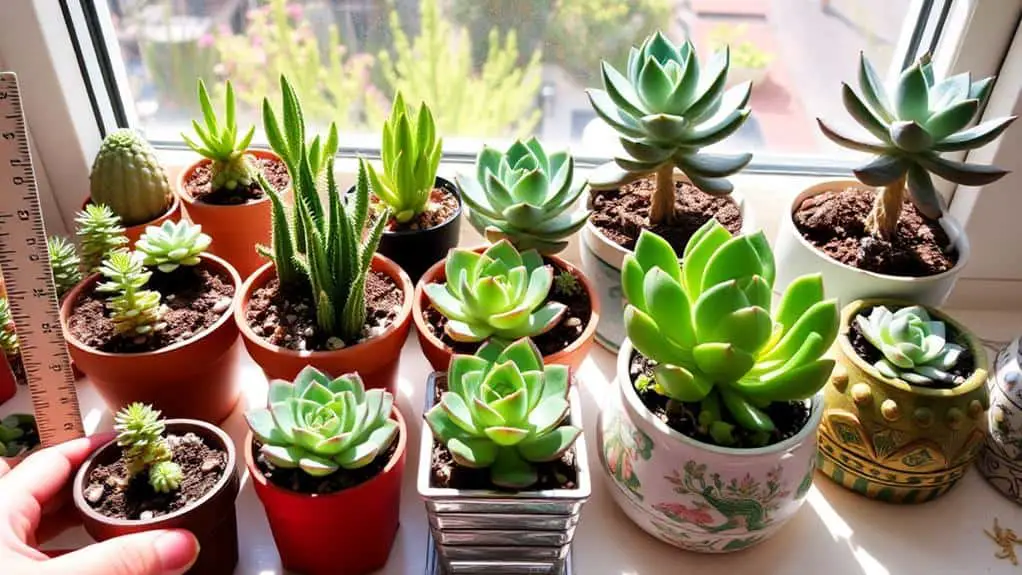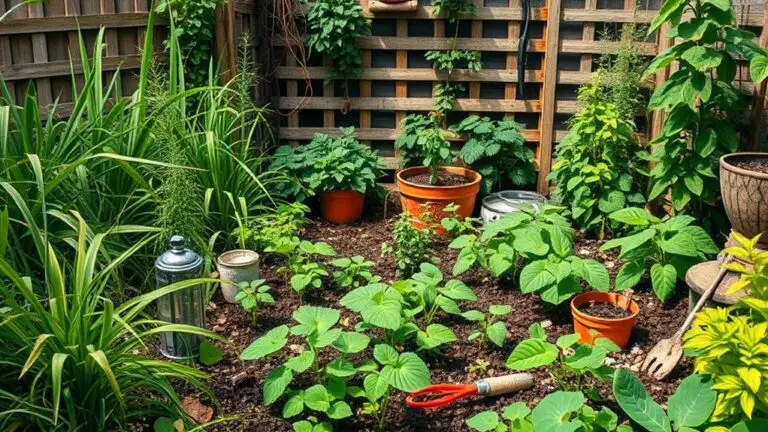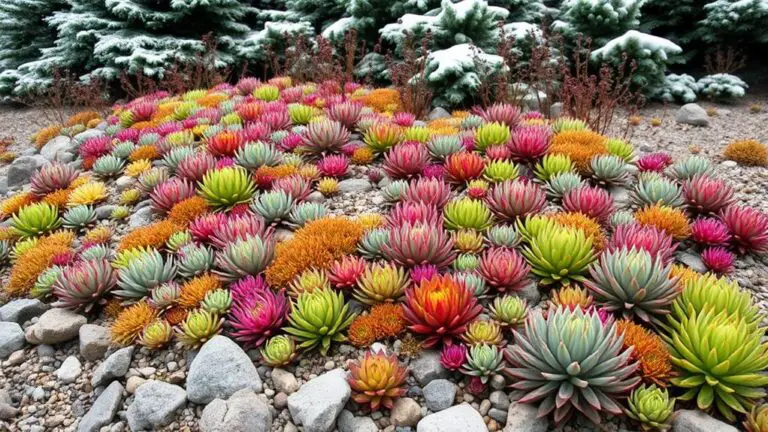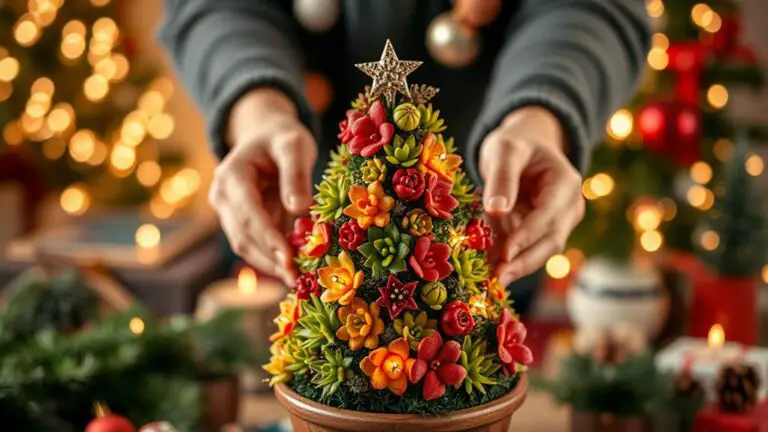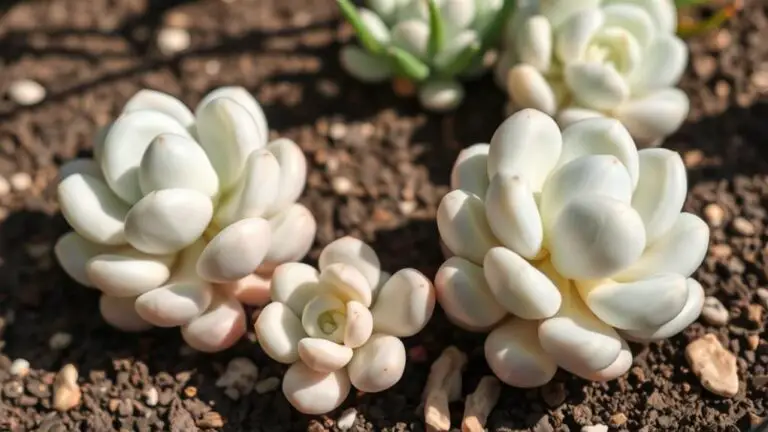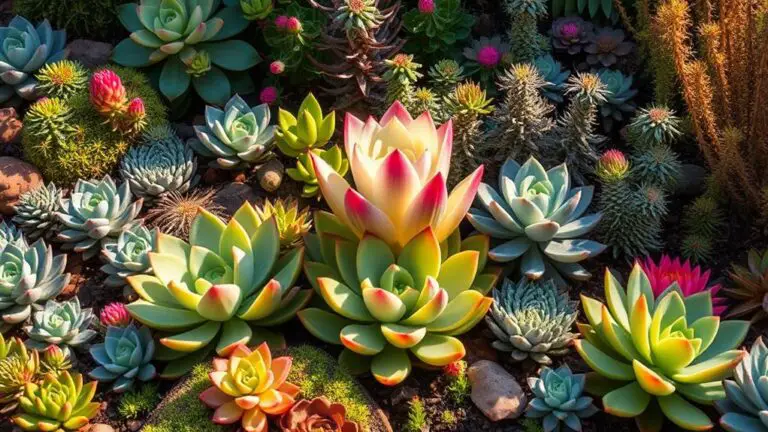How Big Do Succulents Grow?
When you think about succulent growth, you might imagine tiny plants nestled in small pots, but their potential sizes can be surprising. Depending on the species and how you care for them, succulents can range from just a few inches to several feet in height. While indoor varieties like Echeveria stay relatively compact, others like Jade plants can become substantial indoor features. Outdoor succulents, especially in their natural habitats, can reach astonishing heights. Curious about what factors contribute to this wide range of growth? Let's explore the elements that influence just how big your succulents can get.
Factors Affecting Growth
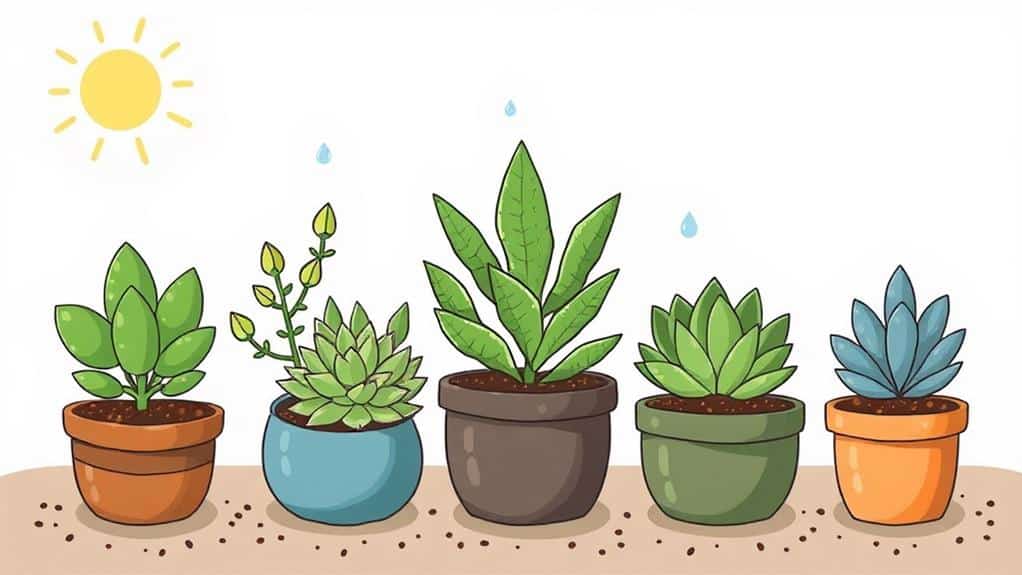
When it comes to growing succulents, several key factors directly affect their growth. Understanding these factors can help you cultivate healthy, thriving plants.
First, light exposure is vital. Succulents typically need 4-6 hours of bright, indirect sunlight each day. This light supports ideal photosynthesis, which is essential for their growth.
Next, consider proper watering practices. It's important to let the soil dry out completely before watering your succulents again. Overwatering can lead to root rot and considerably stunt their growth. So, resist the urge to water them too frequently.
The type of soil you use also plays a big role. Succulents need well-draining soil to prevent moisture retention, which can harm their roots. You can buy special succulent soil or make your own by mixing regular potting soil with sand or perlite.
Lastly, pot size matters. If the container is too small, it can restrict root development. On the other hand, a pot that's too large may hold too much water, leading to overwatering issues.
Choose a pot that's just right for your succulent's size to guarantee healthy growth. By paying attention to these factors, you'll help your succulents grow strong and beautiful.
Light Requirements
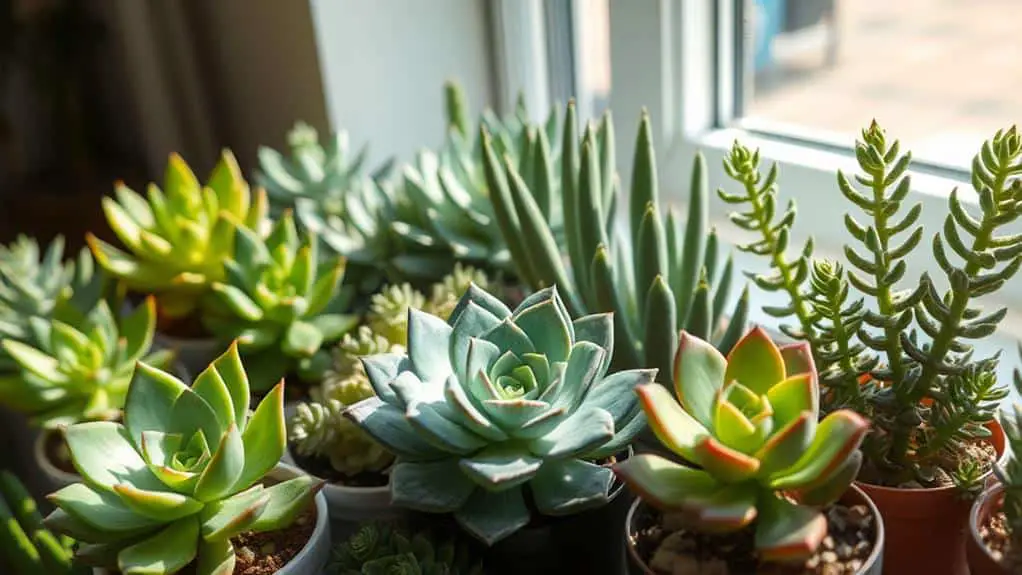
Understanding the light requirements of succulents is essential to their successful growth. Succulents thrive best in bright, indirect sunlight, needing around 4-6 hours of light each day for ideal growth. If they don't get enough light, their growth can slow down considerably because they can't perform photosynthesis properly, leading to leggy or stunted plants.
Be careful with direct sunlight. While it might seem like a good idea, too much direct sun can cause leaf burn, which stops photosynthesis and can make the leaves turn yellow or even develop red tinges. To avoid this, place your succulents where they can get plenty of light without being scorched.
It's also helpful to regularly rotate your succulents. This guarantees they get even light exposure all around, promoting fuller and more symmetrical growth.
Different succulent species have different light tolerance levels, so it's important to understand the specific needs of each type you're growing. By providing the right amount of light, you'll help your succulents grow strong and healthy.
Watering Needs
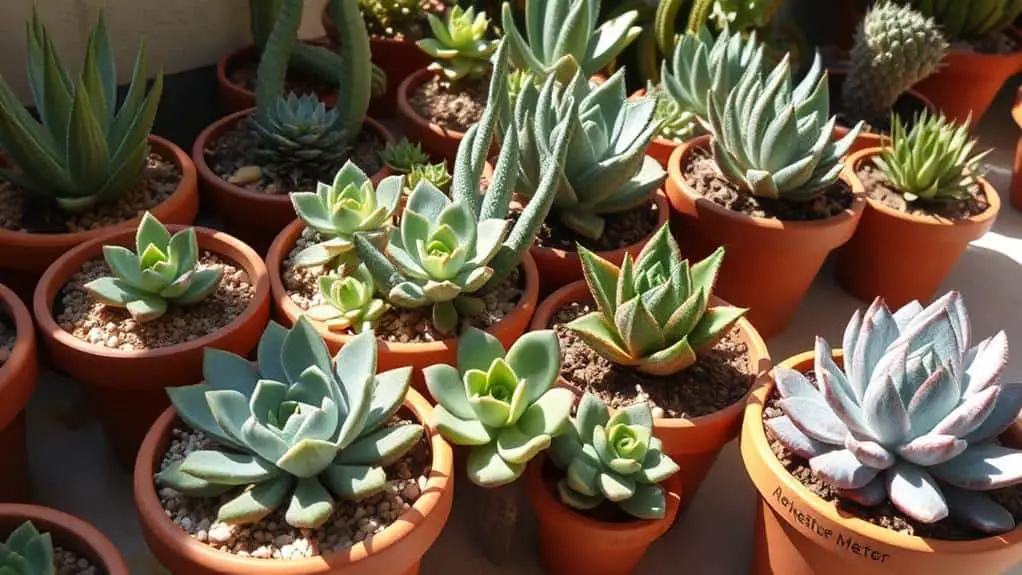
Watering succulents correctly is fundamental to their health and growth. Succulents have unique watering needs compared to other plants. They thrive on infrequent watering. It's essential to let the soil dry out completely between watering sessions, as this helps prevent root rot.
During the summer months, you should water your succulents only when the top inch of soil feels dry to the touch. In winter, they need even less water due to slower growth rates.
Overwatering is a common mistake that can lead to problems like leaf drop and root rot. To avoid this, always check the soil before adding water. Succulents are adapted to survive in dry conditions, so they're more tolerant of drought than excess moisture.
Using well-draining soil is crucial because it guarantees that water doesn't linger around the roots, which can cause damage.
Keep in mind that different succulent species have varying watering needs. Some types are more drought-tolerant than others, so it's important to understand the specific requirements of the succulents you have.
Soil and Nutrients
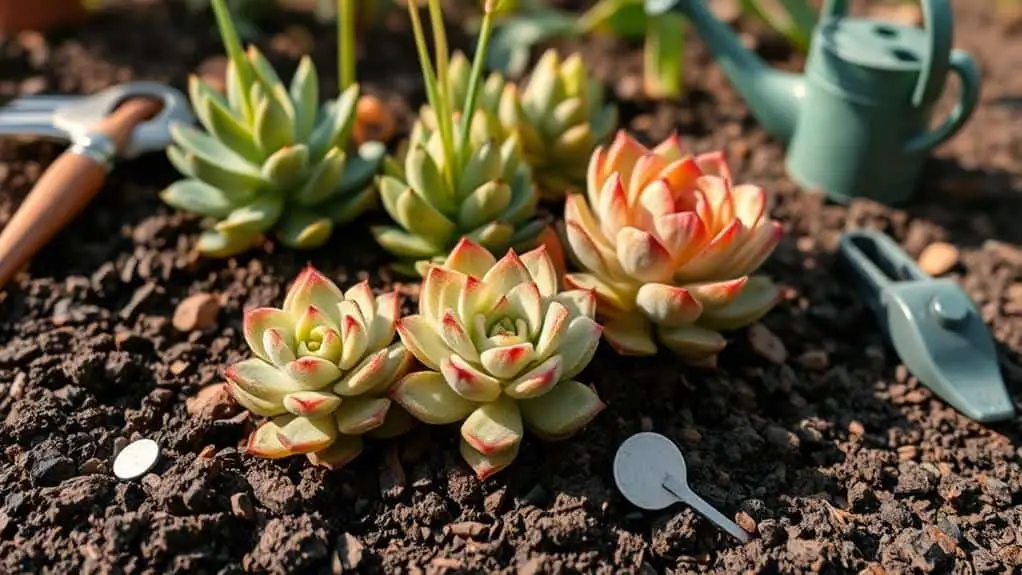
To help your succulents grow big and healthy, you'll need to focus on the right soil and nutrients.
Using well-draining soil like a cactus potting mix or a blend of compost, garden soil, perlite, and sand is essential.
Regularly checking nutrient levels and ensuring the soil drains properly within 30 minutes will keep your succulents thriving.
Importance of Proper Drainage
Ever wondered why proper drainage is so crucial for succulents? Well-draining soil is necessary to prevent root rot and support your plants' growth. Succulents hate sitting in water, and without proper drainage, their roots can become waterlogged, leading to stunted growth and even death.
Here's where a cactus potting mix comes in handy. It's designed to be porous and drain quickly, guaranteeing your succulents thrive.
To guarantee you're giving your plants the best chance, you can create your own soil mix at home. Combine compost, garden soil, perlite, and sand for a customized blend that promotes ideal drainage and nutrient balance.
Don't forget to test your soil's drainage! Ideal soil should let water pass through in about 30 minutes.
Proper drainage isn't just about preventing water accumulation. It also helps keep diseases at bay and guarantees long-term health.
Here's a quick checklist:
- Prevents root rot: Well-draining soil stops water from sitting around the roots.
- Promotes healthy growth: Quick drainage supports robust root development.
- Prevents diseases: Less standing water means fewer pathogens.
Nutrient-Rich Soil Benefits
After ensuring your succulents have proper drainage, it's time to focus on the benefits of nutrient-rich soil.
Nutrient-rich soil is key to supporting ideal growth rates in succulents. It provides essential minerals and organic matter that enhance root development and overall health. When you use a well-balanced soil mix, which includes compost and perlite, you improve moisture retention and drainage. This mix prevents root rot and promotes healthy growth.
Regularly checking the nutrient levels in your soil is essential. It helps you identify deficiencies and allows for targeted fertilization to boost your succulents' health.
Specialized cactus potting mixes are designed to provide the right balance of nutrients and drainage, which supports the unique growth needs of succulents.
Pot Size and Environment
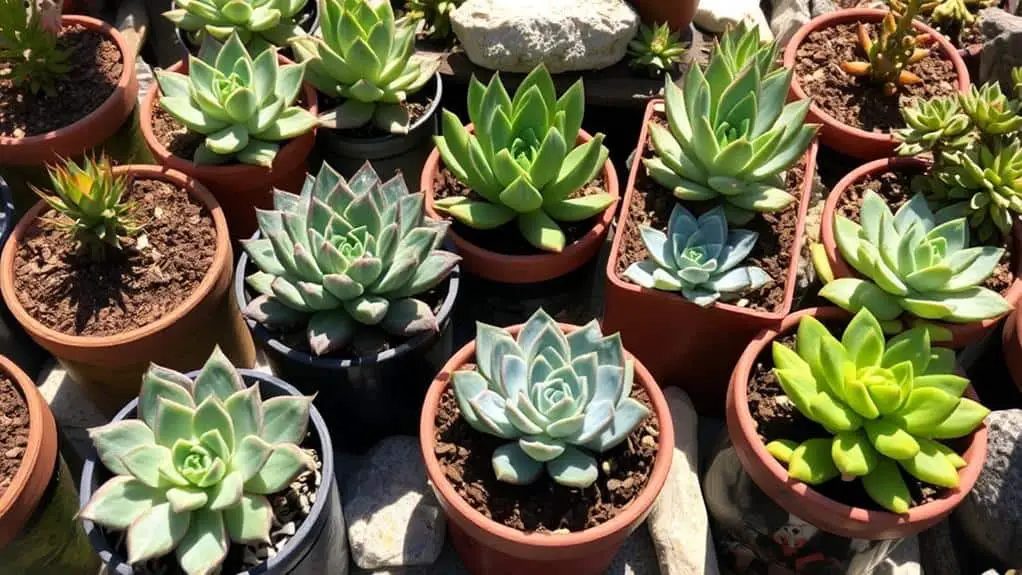
Selecting the right pot size and environment is vital for the healthy growth of your succulents. When choosing a pot, aim for one that's about 1 inch wider than the root diameter. This helps the roots spread out without getting cramped, which prevents root binding.
However, avoid overly large pots, as they can retain too much water, leading to overwatering issues.
For ideal drainage, consider using terracotta or ceramic pots. These materials allow water to evaporate more easily, keeping your succulents' roots dry and healthy. On the other hand, plastic pots tend to hold onto moisture, which can be harmful.
A well-draining soil mix is also important. You can use a commercial cactus potting mix or make your own with compost, garden soil, perlite, and sand. This type of soil mix guarantees that water doesn't linger too long around the roots, preventing root rot and other diseases.
The environment plays a big role in succulent health too. They thrive in warm, dry climates and can be damaged by cold temperatures. Good air circulation is important to prevent fungal infections and promote healthy growth dynamics.
- Use terracotta or ceramic pots for better drainage.
- Guarantee proper air circulation to avoid fungal infections.
- Opt for well-draining soil mixes to prevent root diseases.
Indoor Growth Potential

Indoor succulents offer a diverse range of growth potentials, largely influenced by their species and care. For instance, Echeveria species tend to stay compact, rarely exceeding one foot wide and growing between 2-24 inches tall.
If you're looking for a taller indoor plant, Crassula ovata, commonly known as the jade plant, is an excellent choice. This succulent can reach up to 3 feet tall indoors when given ideal conditions and adequate light.
To maximize the indoor growth potential of your succulents, provide 4-5 hours of bright, indirect sunlight each day. Insufficient light can cause leggy growth, making your plants stretch out and lose their compact form.
Choosing the right pot size, using well-draining soil, and maintaining a consistent watering schedule are key factors in ensuring your succulents thrive.
Outdoor Growth Potential

When you grow succulents outdoors, they can reach impressive sizes thanks to more sunlight and space.
For instance, Agave americana can grow up to 6 feet tall and 10 feet wide, and the Saguaro cactus can eventually stand 45 feet tall in its natural habitat.
Environmental factors like sunlight, temperature, and soil conditions play a big role in how large your succulents will get.
Natural Habitat Size
Succulents can reach impressive sizes when grown in their natural habitats, far surpassing their indoor counterparts. In their native environments, these plants have the space and conditions they need to thrive, resulting in some truly astonishing growth.
Take Agave americana, for instance. This succulent can grow between 3-6 feet tall and spread 6-10 feet wide. The Saguaro cactus is another remarkable example. Over its long lifespan, which can exceed 95-100 years, it can reach heights of 15-30 feet tall.
Even Kalanchoe species, often seen as modest houseplants, can grow up to 6 feet high with a foliage width of 28 inches when in the right outdoor conditions.
In natural habitats, succulents can achieve these sizes due to:
- Ample sunlight: These plants thrive in sunny spots, which they often find in their native environments.
- Well-draining soil: This helps prevent root rot and supports healthy growth.
- Minimal competition for resources: Fewer plants competing for the same nutrients allows succulents to flourish.
When you see succulents in their natural habitats, it's clear that they can become much larger than when confined to pots indoors.
Understanding this can help you better appreciate their potential and care for them effectively.
Environmental Growth Factors
Understanding the impressive sizes succulents can reach in their natural habitats sets the stage for examining the environmental factors that drive this growth.
When you grow succulents outdoors, they often have more potential to grow tall and reach larger sizes compared to indoor plants. This is mainly because outdoor environments provide more favorable light and conditions.
Take Agave americana, for example. Outdoors, this succulent can grow to heights of 3 to 6 feet and widths of 6 to 10 feet. Indoors, you'd rarely see such growth.
The Saguaro cactus is another striking example, growing 15 to 30 feet tall over its lifetime, sometimes even reaching 45 feet in the best conditions.
To maximize the growth size of your outdoor succulents, focus on key environmental factors. They need ample sunlight, which helps them grow tall and strong.
Well-draining soil is also vital, as succulents don't like sitting in water. Finally, a warm, dry climate supports their growth.
Large Succulent Varieties
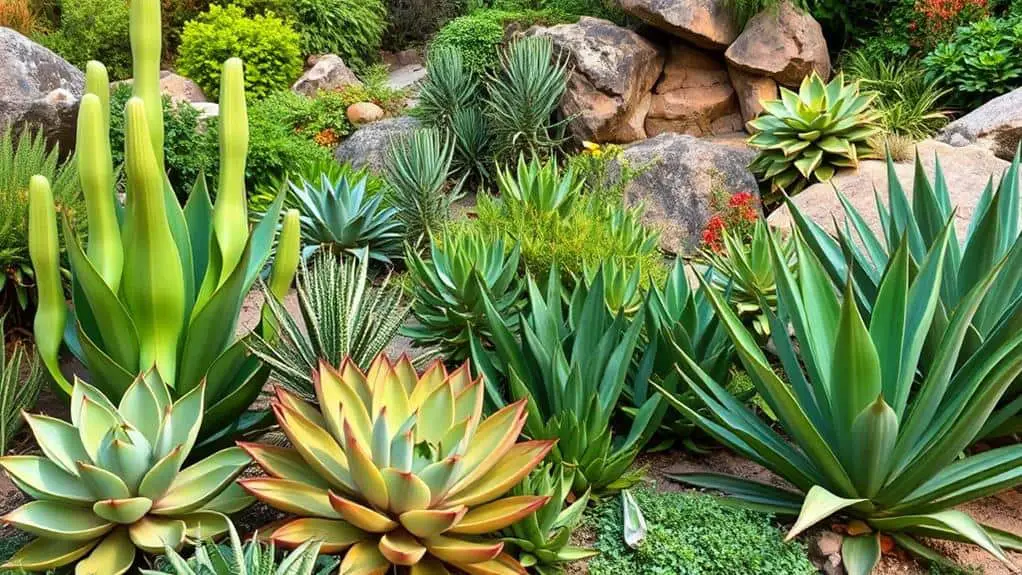
In the world of succulents, some varieties grow to impressive sizes, transforming ordinary garden spaces into striking landscapes. These big succulents can reach several feet in height, making them focal points in any setting.
Let's explore a few notable large succulent varieties.
Agave americana is a true giant among succulents. It can grow up to 24 feet tall and spread 10 feet wide. Its dramatic size makes it a centerpiece in any garden.
Next, the Kalanchoe, particularly the Mother of Millions variety, can grow up to 7 feet tall and 3 feet wide. This plant's bushy growth habit adds lush greenery to your garden space.
- Crassula family (e.g., Jade Plant): Grows up to 15 feet tall in ideal conditions.
- Aloe species (e.g., Tree Aloe): Can tower up to 60 feet, perfect for adding vertical interest.
- Aeonium arboreum: With a tree-like appearance, it reaches up to 5 feet tall.
These large succulent varieties offer unique shapes and sizes, enhancing your garden's visual appeal.
With proper care, they'll flourish, giving you a stunning, lively garden that stands out.
Frequently Asked Questions
How Big Do Indoor Succulents Get?
Indoor succulents' sizes vary. They typically range from 2 to 24 inches tall. Echeverias stay under a foot, while Jade Plants can reach 3 feet. Guarantee proper light to avoid leggy growth, keeping them compact and healthy.
Do Succulents Grow Bigger in Bigger Pots?
Yes, succulents grow bigger in bigger pots because they have more room for root expansion. However, avoid excessively large pots to prevent overwatering. Always balance pot size with proper drainage and soil type for ideal growth.
How Long Does a Succulent Live?
Succulents can live between 5 to 20 years with proper care. Some species, like Jade Plants, can live over 50 years. Ascertain you provide adequate sunlight, avoid overwatering, and maintain good soil quality to maximize their lifespan.
Are Succulents Supposed to Get Big?
Succulents aren't always supposed to get big. It depends on the species and care. Some, like the Jade Plant, can grow tall, while others stay compact. Proper sunlight, pot size, and watering practices are essential for growth.
Conclusion
You've got everything you need to help your succulents thrive! Remember, give them plenty of light, water them just right, and use well-draining soil. Pay attention to their specific needs and they'll reward you with beautiful growth. Indoors or outdoors, succulents can become stunning additions to your space. Don't worry if you're new to this; with a little care and observation, you'll see them flourish. Happy gardening and enjoy watching your succulents grow!

